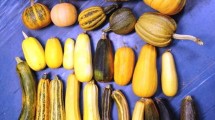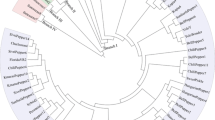Summary
Six Festuca rubra populations from Europe and Scandinavia were studied for variation at three isozyme loci; phosphoglucoisomerase (PGI-2), glutamate oxaloacetate transaminase (GOT-3) and superoxide dismutase (SOD-1). Seven alleles were found at the Pgi-2 locus, four at the Got-3 locus and five at the Sod-1 locus. Most plants were heterozygous and up to five alleles were found in the same plant at the Pgi-2 locus. Each population could be distinguished by the presence or absence of certain alleles or by differences in the frequencies of the alleles present. Values for the Shannon diversity index were calculated which showed that there was considerable heterogeneity both within and between loci. In general, 53% of this diversity could be attributed to within population variation.
Similar content being viewed by others
References
Adams, W.T. & R.W. Allard, 1977. Effect of polyploidy on phosphoglucoisomerase diversity in Festuca microstachys. Proc. Nat. Acad. Sci. (USA) 74: 1652–1656.
Cahn, M.A. & J.L. Harper, 1976. The biology of the leaf mark polymorphism in Trifolium repens L. 1. Distribution of phenotypes at a local scale. Heredity 37: 309–325.
Gottlieb, L.D. & N.F. Weedon, 1981. Correlation between subcellular location and phosphoglucoisomerase variablity. Evolution 35: 1019–1022.
Harberd, D.J., 1961. Observations on population structure and longevity of Festuca rubra L. New Phytol. 60: 184–206.
Harberd, D.J. & M. Owen, 1969. Some experimental observations on the clone structure of a natural population of Festuca rubra L. New Phytol. 68: 93–104.
Hubbard, C.E., 1984. Grasses. 3rd Ed. Penguin.
Humphreys, M.W., 1989. The controlled introgression of Festuca arundinacea genes into Lolium multiflorum. Euphytica 42: 105–116.
Lewis, E.J., M.W. Humphreys & M.P. Caton, 1980. Disomic inheritance in Festuca arundinacea Schreb. Z. Pflanzenzüchtg 84: 335–341.
Lewontin, R.C., 1972. The apportionment of human diversity. In: Dobzhansky, T., M.K. Hecht & W.C. Steele, (Eds). Evolutionary Biology 6: p. 381–398. Appleton-Century-Crofts, New York.
Manwell, C. & C.M.A. Baker, 1970. Molecular biology and the origin of species. (University of Washington Press, Seattle, WA).
Markgraf-Dannenberg, I. 1980. Festuca-In: T.G. Tutin et al., (Eds). Flora Europaea 5: p. 125–153. Cambride University Press.
Silander, J.A., 1984. The genetic basis of the ecological amplitude of Spartina patens. III. Allozyme variation. Botanical Gazette 145: 569–577.
Thomas, H., W.G. Morgan, M. Borrill & M. Evans, 1983. Meiotic behaviour in polyploid species of Festuca. Proc. Kew Chromosome Conf. III: p. 133–138. Allen and Unwin.
Author information
Authors and Affiliations
Rights and permissions
About this article
Cite this article
Livesey, V., Norrington-Davies, J. Isozyme polymorphism in Festuca rubraL.. Euphytica 55, 73–79 (1991). https://doi.org/10.1007/BF00022562
Received:
Accepted:
Issue Date:
DOI: https://doi.org/10.1007/BF00022562




